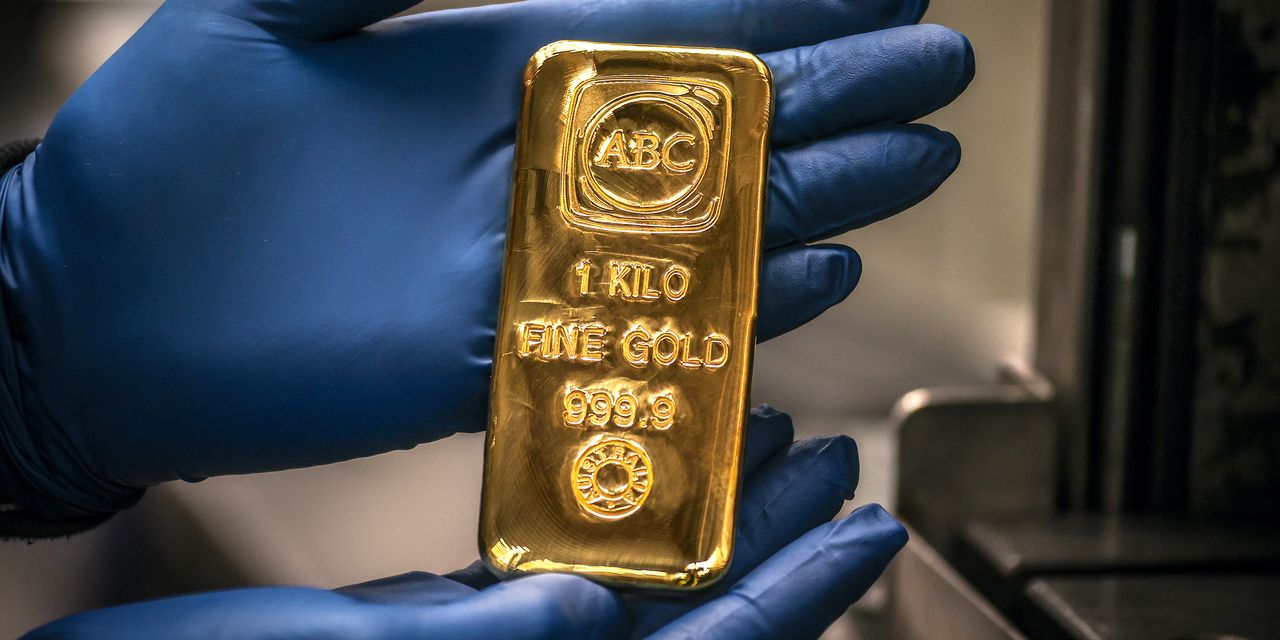Gold futures finished lower on Thursday as the Federal Reserve’s preferred inflation gauge showed an increase for July, contributing to a monthly loss of more than 2%.
Price action
-
Gold for December delivery
GC00,
-0.01% GCZ23,
-0.01%
fell $7.10, or 0.4%, to settle at $1,965.90 an ounce, after ending Wednesday at its highest since Aug. 4. Prices for the most-active contract logged a loss of 2.2% for the month, according to Dow Jones Market Data. -
December silver
SIZ23,
-0.01%
fell 29 cents, or 1.2%, to $24.81 an ounce, ending 0.6% lower month to date. -
December copper
HGZ23,
+0.29%
settled at $3.82 a pound, down 0.6% for the session to lost 4.6% for the month. -
Platinum for October delivery
PLV23,
+0.26%
shed 0.9% to $974.40 an ounce, ending nearly 1.7% higher for the month, while December palladium
PAZ23,
+0.85%
lost 0.8% to $1,218.70 an ounce, marking a monthly loss of 4.5%.
Market drivers
Gold futures finished lower Thursday after a reading of the U.S. July personal consumption expenditures index revealed a increase of 0.2%, matching the forecast from economists polled by The Wall Street Journal. Overall inflation, however, crept higher and remained stuck above 3%.
Against that backdrop, the U.S. dollar strengthened, with the ICE U.S. Dollar index
DXY
up 0.4% at 103.594 in Thursday dealings, pressuring dollar-denominated prices of gold.
Jim Wyckoff, senior analyst at Kitco.com said gold saw a “modest downside correction” in the wake of the the inflation data, following gains for the precious metal so far this week. However, gold and silver bulls “still have some momentum on their side,” he said in daily commentary.
For the week, gold futures trade over 1% higher, contributing to a roughly 7.7% rise year to date.
Gold found support this week after weaker-than-expected U.S. labor data, including Tuesday’s job openings and labor turnover survey, or JOLTS, report and Wednesday’s private-sector payroll figures from Automatic Data Processing came in weaker than expected.
Gold was buoyed as the data saw investors scale back expectations for a further Fed interest rate increase, which allowed the U.S. dollar and Treasury yields to pull back. A higher dollar can make gold more expensive to users of other currencies, while higher bond yields raise the opportunity cost of holding assets that don’t produce a yield.
Gold is in the middle of another rebound, “thanks to some negative economic data points, falling yields and vanished expectations of another Fed rate hike,” said Brien Lundin, editor of Gold Newsletter, in emailed commentary.
Whether this rally is for real is too early to tell — and the move is “still new and fragile,” he said. Still, there are “compelling reasons to believe that gold has turned the corner.”
Overall, odds for a quarter-point interest-rate hike at the Fed’s Sept. 20 have declined, based on the CME FedWatch Tool.
Investors are once again beginning to price in the end of rate hikes, though not quite as eager to predict rate cuts, said Lundin.
All told, “big money is still recognizing that this hiking cycle is drawing to a close and the next big change in monetary policy will bring the gold price higher and the relative value of the dollar lower,” he said.
The main event for this week, however, is likely to remain Friday’s U.S. August jobs report, analysts said.
See: Hiring likely slowed again last month, but watch out for surprises in U.S. August jobs report
“Should the U.S. labor market give more signs of weakness, there may be scope for further gold gains. However, even in the medium-to long-term, these gains will be limited because even if the Fed doesn’t hike again, rates will remain elevated for a prolonged period,” Ricardo Evangelista, senior analyst at ActivTrades, said in a note.
Read the full article here













Leave a Reply